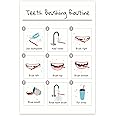In the realm of oral health education, the use of dental teeth models plays a pivotal role in enhancing understanding and awareness among students, patients, and the general public. These models serve as invaluable tools in communicating complex dental concepts, demonstrating procedures, and promoting preventive care. This article delves into the multifaceted importance of dental teeth models, exploring their applications, benefits, and impact on oral health education.
Understanding Dental Teeth Models
Dental teeth models are replicas of human teeth and jaws, created using materials like plastic, resin, or wax. They can vary in complexity from simple single tooth models to comprehensive sets that include the entire dental arch and surrounding structures. These models are used in various settings, including dental schools, clinics, and community health programs, to facilitate learning and understanding.
The Role of Dental Models in Education
Dental teeth models are instrumental in oral health education for several reasons:
- Visual Learning: Models provide a tangible representation of dental anatomy, enabling students and patients to visualize complex structures and relationships.
- Hands-On Practice: Students can practice techniques like tooth brushing and flossing on models, which helps build confidence and competence before working on real patients.
- Enhanced Communication: Dental professionals can use models to explain diagnoses and treatment options to patients more effectively, bridging the gap between technical jargon and patient understanding.
- Promoting Preventive Care: Models can illustrate the consequences of poor oral hygiene, helping to instill a sense of responsibility for personal dental care in patients.
Applications of Dental Teeth Models in Various Settings
The versatility of dental teeth models allows them to be utilized in diverse educational and clinical settings:
1. Dental Schools

In dental schools, models are integral to the curriculum, serving as teaching aids in anatomy, pathology, and restorative dentistry. For instance, students can learn about:
- The anatomy of deciduous versus permanent teeth.
- Common dental conditions, such as cavities or gum disease.
- Restorative techniques, including crowns and bridges, through simulated procedures.
2. Clinical Practice

Dental professionals use models in their practices to:
- Educate patients about their oral health status.
- Demonstrate proper oral hygiene techniques.
- Explain treatment plans, including orthodontic procedures.
3. Community Health Programs
Community outreach initiatives often utilize dental models to:
- Conduct workshops on oral hygiene for children.
- Provide education on the importance of regular dental check-ups.
- Encourage healthy dietary choices that support oral health.
Case Studies Highlighting the Impact of Dental Models
Several case studies illustrate the effectiveness of dental teeth models in improving oral health education:
Case Study 1: Improving Dental Hygiene in Schools
A study conducted in a local school district found that using dental models during oral health presentations significantly improved students’ understanding of proper brushing and flossing techniques. After incorporating models into their curriculum, the school reported:
- A 30% increase in students who correctly demonstrated brushing techniques.
- A 25% reduction in reported dental caries among participating students over a year.
Case Study 2: Enhancing Patient Communication

A dental clinic implemented the use of dental models to educate patients about periodontal disease. The results were compelling:
- Patients were 40% more likely to understand their diagnosis when models were used during consultations.
- Follow-up surveys indicated that patients felt more empowered to maintain their oral health, leading to higher adherence to treatment plans.
Statistics Supporting the Use of Dental Models

Numerous studies have highlighted the benefits of using dental models in education:
- A survey of dental educators revealed that 85% believe models significantly enhance student comprehension of dental anatomy.
- Research indicates that visual aids, like dental models, can improve retention of information by up to 65% compared to traditional methods.
- In a clinical trial, patients who received education through models reported a 50% increase in their understanding of dental procedures.
The Future of Dental Teeth Models in Education

The future of dental education is poised for innovation with advancements in technology. Virtual reality (VR) and 3D printing are emerging trends that can enhance the traditional use of dental models:
- 3D Printing: Custom dental models can be created to represent individual patient anatomy, allowing for personalized education and treatment planning.
- Virtual Reality: VR technology can simulate dental procedures, providing an immersive learning experience for students and patients alike.
Conclusion: The Lasting Impact of Dental Teeth Models

In conclusion, dental teeth models are indispensable tools in oral health education, bridging the gap between theoretical knowledge and practical application. Their ability to enhance understanding, facilitate communication, and promote preventive care underscores their importance in both educational and clinical settings. As dental education continues to evolve, the integration of traditional models with innovative technologies promises to further enhance the quality of oral health education, ultimately leading to improved patient outcomes and a healthier society.
By investing in effective educational strategies, including the use of dental models, we can empower individuals to take charge of their oral health and foster a culture of preventive care that benefits everyone.


